In the labyrinth of healthcare technology, where innovations emerge daily to fine-tune patient care, Electronic Health Records (EHRs) stand as the sentinel of modern medical data management. Among the pantheon of EHR solutions, Allscripts has carved a niche for itself. But what makes Allscripts more than a mere record-keeping tool? It’s the art of integration. In this comprehensive guide, we’ll explore the mosaic of Allscripts EHR integration and why mastering it is pivotal for healthcare enterprises.
Top Takeaways:
- Allscripts shines as an integration beacon in the EHR field, combining user-friendly features with extensive data access. Providers looking to integrate Allscripts EHR should know that this flexible system caters to various healthcare needs, reflecting Allscripts’ dedication to innovation and top-notch patient care.
- Successful Allscripts EHR integration hinges on careful planning, understanding Allscripts APIs, robust framework building, meticulous data mapping, thorough testing, and ongoing support.
- Navigating the complexities of integrating Allscripts EHR requires balancing compliance, security, user-centric designs, and optimizing performance. These pillars are essential for turning challenges into opportunities to enhance healthcare delivery with efficient, secure, and patient-focused digital solutions.
Table of Contents:
What Is Allscripts EHR?
Key Features and Capabilities of Allscripts EHR
Benefits of Integrating Allscripts EHR
Allscripts EHR Integration Solutions Step-By-Step Guide
- Step 1: Choosing the Right Approach
- Step 2: Understanding Allscripts APIs
- Step 3: Building the Integration Framework
- Step 4: Data Mapping and Transformation
- Step 5: Testing and Quality Assurance
- Step 6: Post-Integration Support
Challenges and Best Practices for Allscripts EHR Integration
How Topflight Can Help with Allscripts EHR Integration
What Is Allscripts EHR?
Allscripts is not just another EHR vendor in the healthcare industry; it’s a seasoned pioneer. An electronic powerhouse driving patient care forward, its functionalities pivot around ease of use, streamlined workflows, and comprehensive patient data access. But what truly elevates Allscripts is its ecosystem – extensive, flexible, and ripe for integration, catered to a diverse spectrum of healthcare needs.
When considering the competitive landscape of EHR, particularly in terms of market share, it’s crucial to understand where Allscripts stands in relation to giants such as Epic and Cerner. Recent statistics provide illuminating insights. Though exact figures can fluctuate, Allscripts has consistently held its ground as a formidable player among other EHR software products.
- Epic – 41%
- Cerner – 23 %
- MEDITECH – 13%
- Evident – 8%
- Allscripts – 3%
According to the latest data, Epic leads the market, particularly within large hospital networks, with Cerner not far behind, especially in medium to large hospitals. Allscripts, while not leading, boasts a significant presence in smaller to medium-sized healthcare facilities and has made impressive inroads in specific healthcare sectors, such as ambulatory services, that are often underrepresented in broader market analyses.
Quick stats and facts about Allscripts EHR:
- 2022 revenue $0.83 billion
- Market cap in 2023: $1.14 billion; in 2024 – $0.86 billion
- over 180,000 physician users
- used by 45,000 physician practices, 19,000 post-acute agencies, 2,500 hospitals, 100,000 electronic-prescribing physicians, and 40,000 in-home clinicians
- changed its name from Allscripts to Veradigm in January 2023
What’s particularly persuasive about Allscripts, beyond the raw metrics of market share, is its commitment to integration and interoperability. This approach not only provides a competitive edge but also signifies a forward-thinking strategy that values comprehensive patient care over sheer market dominance. It’s this dedication to innovation and seamless integration that ensures Allscripts remains a key player in the EHR market, offering a versatile and robust platform for healthcare enterprises aiming to deliver superior patient care in an increasingly digital world.
Related: How to Develop EHR/EMR System
Key Features and Capabilities of Allscripts EHR
Dive into Allscripts electronic health record integration, and you’ll unravel a treasure trove of features that resonate with clinical efficacy and operational efficiency:
Intuitive Interface Design
Allscripts’ user-friendly layout not only fosters ease and speed of use but also provides a seamless experience for healthcare professionals navigating through the complexities of health IT systems. This simplicity in design is a rare gem that enhances efficiency and user satisfaction in managing patient data and healthcare workflows.
Clinical Decision Support (CDS)
Enhances healthcare decisions by seamlessly integrating the most up-to-date evidence-based guidance directly into the care process, ensuring that patients receive the most effective and cutting-edge treatment options available in the medical field.
Read more on clinical decision support systems implementation
Telehealth Capabilities
By integrating telehealth functionalities directly within the EHR, Allscripts facilitates remote patient monitoring and virtual consultations, thereby extending the reach of healthcare services beyond traditional settings and fostering a more inclusive healthcare ecosystem.
Interoperability
Allscripts is not an isolated island – it integrates with pharmacies, labs, medical billing systems, and devices, bridging the gaps in healthcare data. With the right team, Allscripts EHR can connect virtually to any custom-built app or existing system.
Also Read: A Guide to EHR Interoperability and EHR in medical billing
Integration into Patient Portals
This integration empowers patients, giving them direct access to their health records, lab results, and the ability to communicate with their healthcare providers. It’s a digital empowerment that shifts patients from passive recipients to active participants in their healthcare journeys.
Related: How to Build a Patient Portal App
Analytics and Reporting Tools
Another noteworthy functionality is the platform’s powerful analytics and reporting tools. These tools provide actionable insights into patient populations, enabling healthcare organizations to identify trends, manage chronic diseases more effectively, and improve overall population health.
In emphasizing these functionalities, Allscripts demonstrates its role not just as an EHR platform but as a comprehensive, interconnected engine driving forward the future of healthcare technology, making it an invaluable asset for healthcare enterprises aiming to thrive in an increasingly digital landscape.
Benefits of Integrating Allscripts EHR
This isn’t just about plugging a system; it’s about fortifying your healthcare arsenal. Integrate Allscripts EHR, and you access a myriad of advantages:
Reduced Errors
Integration helps in automating processes, slashing the odds of human error in data entry.
Enhanced Patient Experience
With integrated Allscripts, the patient’s entire medical history is just a click away, leading to more personalized care.
Streamlined Workflow
By knitting various data sources, it paves the way for workflow automation and standardization.
Scalability
Allscripts grows with you. Integration and the use of cloud technologies allow for additional modules in the future to meet new healthcare demands.
Related: Cloud Computing in Healthcare
Optimized Costs
The cost-effectiveness of Allscripts is not just limited to its tailored pricing plans but also the potential reduction in costs that result from streamlined workflows and enhanced efficiency.
Meaningful Use (MU) Certification
With seamless interoperability, Allscripts ensures that healthcare organizations meet MU requirements by the Centers for Medicare & Medicaid Services (CMS) EHR Incentive Program.
With a proven track record of innovation and commitment to seamless integration, Allscripts continues to be a leading player in the EHR market, empowering healthcare organizations to deliver superior care within an increasingly complex digital environment.
Allscripts EHR Integration Solutions Step-By-Step Guide
Here’s the roadmap to Allscripts EHR integration – from picking your compass to navigating the often tumultuous sea of tech:
| Step | Description |
|---|---|
| 1. Choosing the Right Approach | Select an integration method: Interface Engine, API, or pre-built application, each with its unique benefits and challenges. |
| 2. Understanding Allscripts APIs | Explore Allscripts’ APIs, from user-centric to clinical modules, to unlock their full potential for tailored solutions. |
| 3. Building the Integration Framework | Create a scalable and adaptable framework to meet current and future integration needs. |
| 4. Data Mapping and Transformation | Ensure seamless data flow between systems by mapping and transforming patient data accurately. |
| 5. Testing and Quality Assurance | Conduct rigorous testing to ensure compatibility, data fidelity, and compliance with regulatory standards. |
| 6. Post-Integration Support | Establish ongoing support to address issues, adapt to changes, and ensure system reliability over time. |
Step #1: Choosing the Right Approach
Selecting the integration approach is fundamental. Will you take the traditional Interface Engine route, the API directive, or go full-throttle with a pre-built application? Each option has its unique benefits and challenges.
The traditional Interface Engine route offers tried-and-tested reliability but may lack the agility needed for modern healthcare demands. The API approach, on the other hand, promises flexibility and direct access to Allscripts functionalities, while pre-built applications can significantly shorten development time but may limit customization options.
Check out our EHR integration services
Step #2: Understanding Allscripts APIs
Allscripts offers a bouquet of APIs – from user-centric modules to administrative and clinical ones. Understanding these is crucial. Deep diving into the specifics of each API module will not only facilitate a smoother integration but also unlock the full potential of Allscripts EHR capabilities, enabling custom solutions that cater directly to user needs.
Step #3: Building the Integration Framework
Lay the foundation with a robust integration framework – one that scales, adapts, and innovates. An effective framework not only supports current integration requirements but also anticipates future needs and technological advancements. This foresight (of which pieces of existing and planned infra Allscripts EHR integrates with) can be a game-changer, ensuring your integration remains relevant and efficient in the long run.
Step #4: Data Mapping and Transformation
Data is the currency of healthcare; integrating different systems means translating this currency effectively. Data Mapping and Transformation are your translators.
This step ensures that patient information flows seamlessly between systems, maintaining its integrity and confidentiality. Proper data mapping reduces the risk of errors, ensuring that healthcare providers have accurate and up-to-date information at their fingertips.
Step #5: Testing and Quality Assurance
Before rolling out any integration, rigorous testing is non-negotiable. Ensure system compatibility and data fidelity through comprehensive QA processes.
This phase not only iron out any technical glitches but also verifies that the integration meets all regulatory compliance standards, safeguarding patient data and ensuring the system’s reliability.
Step #6: Post-Integration Support
Integration is not a one-time event. Ensure a strong support system to tackle glitches, updates, and adapt to changing regulatory requirements.
Continuous support and maintenance are key to adapting to the dynamic healthcare landscape, ensuring that the integration remains functional and effective over time.
Related: EHR Implementation Guide
At Topflight, we pride ourselves on our deep expertise and comprehensive understanding of healthcare app development, including in the realm of Allscripts EHR integration. Our experience has shown us that a meticulous approach, detailed planning, and ongoing support are the cornerstones of successful integration projects.
By following the steps outlined above, healthcare organizations can not only achieve seamless Allscripts integration but also harness the full potential of digital health solutions to improve patient care and operational efficiency.
Challenges and Best Practices for Allscripts EHR Integration
While the horizon is rife with benefits, it is wise to steer clear of challenges by putting these best practices into play:
Ensuring Compliance
HIPAA, GDPR, and a host of other regulations loom over healthcare data. Ensure your integrations always comply. Compliance is all about embedding privacy and security into the fabric of your health experience and requires a proactive approach to integrating them into your system. By prioritizing compliance from the get-go, you not only protect patient data but also build trust with your end-users, laying a solid foundation for your application’s success.
Also Read: HIPAA Compliant App Development
Security First
When integrating EHRs like Allscripts, you’re not just accessing data; you’re safeguarding a treasure trove of PHI. This calls for a security-first mindset, where robust security frameworks are not optional but mandatory. Implementing advanced encryption, multi-factor authentication, and regular security audits can fortify your integration against breaches.
See how edge computing for healthcare solves similar security challenges
Read more on healthcare app development.
Leveraging SMART on FHIR for Health Apps Integration
One of the groundbreaking features that Allscripts offers is the use of SMART on FHIR development standards to enhance its EHR’s capabilities. This sophisticated framework enables health apps to launch directly within the Allscripts EHR interface or as standalone applications, ensuring a seamless transition between the app and the EHR system.
User-Centric Design
At the crux of any system’s utility is user buy-in. Designing your Allscripts integration with a user-centric approach means understanding and addressing the real-world needs and processes of healthcare providers and patients. It’s about creating intuitive interfaces, simplifying complex processes, and ensuring that every feature adds tangible value to the user’s experience.
Performance Optimization
The integration of EHR systems like Allscripts can place a significant demand on system resources, potentially leading to slower response times and a diminished user experience. Performance optimization is critical in ensuring that your integration does not become a bottleneck in patient care. This involves streamlining data processing, optimizing code, and employing caching strategies to enhance system responsiveness.
Related: Cost of EHR Implementation
How Topflight Can Help with Allscripts EHR Integration
Closing the loop, consider Topflight’s EHR Allscripts integration team as your wingman in the EHR integration airspaces. With a squadron of experts seasoned in the peculiarities of Allscripts EHR and a battle-hardened approach to integration, Topflight can be the difference between mere EHR usage and EHR effectiveness.
Expertise at Every Phase: With Topflight, you’re not just hiring a developer; you’re tapping into a well of expertise at every phase of integration, from planning to maintenance.
Post-Integration Optimization: Integration is just the first step. Topflight’s focus on optimization ensures your EHR’s performance is top-notch in the long haul.
Success Stories as Blueprints: Consider our work with Allscripts professional EHR integrations as a testament to what’s possible. While we highlight a specific project that showcases our capabilities, it serves as a broader blueprint for how seamless integration can be achieved.
Project Spotlight: In a standout project, we set out to revamp a complete practice management (PM) solution. Our mission? To streamline the clinical, financial, and administrative workflows into one seamless platform, eliminating redundant interface costs and ensuring real-time data updates.
- Our Solution: Utilizing cutting-edge technology, we developed a PM web client and integrated it with EHR servers (EPIC and AllScripts) via a SMART on FHIR API javascript library, complemented by a secure EHR oAuth2 Authentication server.
- Results: Achieved in 9 months and ONC-ACB certified shortly after, the solution is now a cornerstone of healthcare facilities across SC and Europe, showcasing our ability to deliver enduring and adaptive EHR solutions.
Related: How to integrate your health app with EHR
In the era of healthcare digital transformation, Allscripts EHR integration is more than a necessity; it’s a strategic asset. By leveraging its capabilities, healthcare providers can not only streamline their efforts but also elevate the standard of patient care. And with Topflight in your corner, you’re one step closer to unraveling the true potential of Allscripts EHR.
Remember, in the competitive healthcare landscape, the integration-savvy will thrive, not just survive. It’s time to go beyond EHR – it’s time to integrate. Reach us here!
[This blog was originally published on April 12,2024 and has been updated for more recent content]
FAQ
How much does Allscripts EHR integration cost?
The cost of Allscripts EHR integration can vary widely based on the complexity of the integration, the chosen approach, and the specific needs of your healthcare organization. Generally, it involves initial set-up fees and ongoing maintenance costs. Consulting with an integration specialist like Topflight can give you a more precise estimate tailored to your requirements.
Why integrate Allscripts into your mobile app or platform?
Integrating Allscripts into your mobile app or platform enhances functionality, improves patient engagement, and streamlines workflows. It allows healthcare providers to access vital patient information on the go, ensures up-to-date patient data is available at the point of care, and facilitates better decision-making processes. Ultimately, it elevates the quality of healthcare services provided.
What are the type of integrations with Allscripts?
Integration with Allscripts can be achieved through various methods, including traditional Interface Engine integration, using Allscripts’ APIs for more flexible and dynamic interactions, or by leveraging pre-built applications. Each method offers different advantages and is chosen based on the specific needs and capabilities of the healthcare provider.
How do you start integrating with Allscripts?
Starting with Allscripts integration involves several key steps: 1. Define the scope and objectives of your integration project. 2. Choose the right integration approach (API, Interface Engine, or pre-built application). 3. Understand and get access to the necessary Allscripts APIs. 4. Develop a robust integration framework, including data mapping and transformation. 5. Conduct thorough testing and quality assurance. 6. Deploy the integration with post-integration support in mind. Working with an experienced integration partner like Topflight can streamline this process.
What are the challenges of implementing an Allscripts EHR for a patient portal?
Implementing an Allscripts EHR for a patient portal involves addressing several challenges, including ensuring data security and compliance with healthcare regulations like HIPAA and GDPR. Integrating disparate systems and maintaining data integrity are also significant concerns. Additionally, achieving a user-friendly design that engages patients while providing them with comprehensive health information is crucial for adoption. Lastly, ongoing support and optimization post Allscripts EHR integration are necessary to adapt to evolving healthcare standards and technology advancements.




